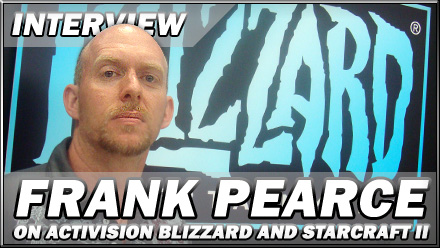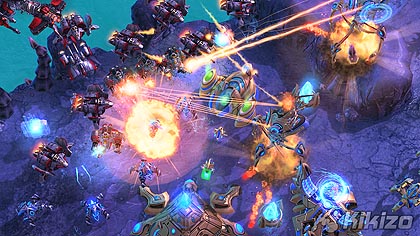Interview: Blizzard Co-founder Frank Pearce
We sit down with the man running the show at Blizzard to discuss the what the unprecedented Activision Blizzard means, and get the latest chat on StarCraft II.

The creation of Activision Blizzard is not particularly straightforward. A merger that involved multiple subsidiaries of two companies, a lot of people in suits and a whole army of developer and publishing talent around the world, its story takes a little while to get your head around, but at the same time concludes with a picture of a united corporation that, by our judgement, now looks calm, organised, and confident.
The merger itself is discussed in our interview with Blizzard co-founder (and Vice president of Blizzard Entertainment), Frank Pearce. Joining us was Bob Colayco, Associate Public Relations Manager for the division. We first started off with some chat about the long awaited sequel that is StarCraft II, before discussing the corporate stuff (which starts on page three).
Kikizo: What was it about the original StarCraft that made it popular, and why has it taken a decade for us to be looking at this sequel?
Frank Pearce: There are a number of things you can attribute to the success of StarCraft. Certainly, the Battle.net platform, which you can play multiplayer matches on, is a big factor, because that's what connects the StarCraft community online. With that community, players know they can go online and find an opponent to play. So that's a big factor. In Korea, the emergence of PC gamers and e-sport is certainly quite a big factor, because StarCraft was adopted early on as a title for competitive, professional gaming. You know, we like to focus on making games that are fun and compelling, and immersive. So it seems like we achieved that with StarCraft.
As for ten years - the development team that's working on StarCraft II is the same development team that worked on Warcraft III. So in between the first StarCraft and StarCraft II, they were working on Warcraft III games, so it was just a factor of what development teams we had available, and what they wanted to work on.
Kikizo: One of the things I found interesting is that since you've announced the game, some of the game's features have changed based on user community feedback. While it's quite common to update or change an existing game with patches, DLC or whatever, it's unusual for an unreleased game, based on its announcement features...
Bob Colayco: I don't know that we'd call them features; there have been changes to units and their abilities, some units have come in and out of the game, but at this point I don't know how directly attributable it is to community feedback. As Frank has been saying, we kind of put more weight on the type of feedback we get once people have had hands-on and actually played the game. When they're just kind of reacting to what's been written about the game, in magazines or online, or just looking at screenshots, it doesn't necessarily have the perspective as someone who will be playing the actual game. But units and abilities have been changing almost on a daily basis. Certainly the current build plays a lot better than the build we had a year ago.
Pearce: Even after we announced the product, it's still work in progress. Everything is subject to change - nothing's locked down until we do a gold master, and then we won't make changes.
Kikizo: Can you give us an overview of how the development is structured, how you are managing the development, the size of the team and so on?
Pearce: The development team is about 40 people strong, which by some standards today is a pretty small development team. There's a bunch of RTS veterans on the team - like I mentioned it's the same team that worked on Warcraft III, so there's a good number of people that worked on Warcraft III. There's also some developers on the team that worked on the original StarCraft. The breakdown is programmers, artists, game designers and, well, we call them producers, but most industries call them project managers. And there's about maybe 12-14 programmers, 8-10 artists, and four or five project managements type folks, and then the balance is made up of designers. The team has a leadership structure, so there's an art director, a lead programmer responsible for the engine and technology, there's a lead programmer responsible for implementation of the gameplay, there's a lead designer, and there's a creative director responsible for the lore - like the storyline, and the universe. And so that leadership team is responsible for the day-to-day strategic direction and management of the team base.
Kikizo: Still though, as you said, it is a small team...
Pearce: The World of Warcraft team has 130 people!







 Satoru Iwata Video Interview - the late Nintendo president spoke with Kikizo in 2004 as 'Nintendo Revolution' loomed.
Satoru Iwata Video Interview - the late Nintendo president spoke with Kikizo in 2004 as 'Nintendo Revolution' loomed. Kaz Hirai Video Interview - the first of Kikizo's interviews with the man who went on to become global head of Sony.
Kaz Hirai Video Interview - the first of Kikizo's interviews with the man who went on to become global head of Sony. Ed Fries Video Interview - one of Xbox's founders discusses an epic journey from Excel to Xbox.
Ed Fries Video Interview - one of Xbox's founders discusses an epic journey from Excel to Xbox. Yu Suzuki, the Kikizo Interview - we spend time with one of gaming's most revered creators.
Yu Suzuki, the Kikizo Interview - we spend time with one of gaming's most revered creators. Tetris - The Making of an Icon: Alexey Pajitnov and Henk Rogers reveal the fascinating story behind Tetris
Tetris - The Making of an Icon: Alexey Pajitnov and Henk Rogers reveal the fascinating story behind Tetris Rare founders, Chris and Tim Stamper - their only interview? Genuinely 'rare' sit down with founders of the legendary studio.
Rare founders, Chris and Tim Stamper - their only interview? Genuinely 'rare' sit down with founders of the legendary studio. The History of First-Person Shooters - a retrospective, from Maze War to Modern Warfare
The History of First-Person Shooters - a retrospective, from Maze War to Modern Warfare